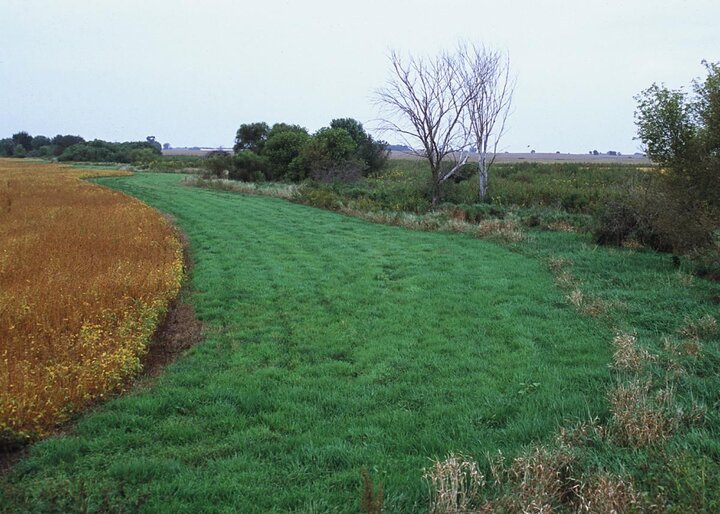After a wrenching year of storms and floods across much of the state, the post-harvest window offers an opportunity to identify problem field areas that would benefit from installing soil conservation measures. To encourage their use, the Nebraska Department of Agriculture is offering financial incentives for vegetative buffer strips. Placed between a crop field and waterway, buffer strips help reduce the amount of sediment, fertilizer, and pesticide entering waterways. Buffers also can serve as wildlife habitat or be used to meet setback requirements required by some pesticides.
Buffer strips have been shown to remove 30-60% of pesticides in field runoff, depending on site conditions such as the width of filter strip, pesticides used, field conservation practices, runoff volume, and other factors. They also have been shown to remove 75% or more of sediment.

The NDA Nebraska Buffer Strip Program will pay landowners to use filter strips (narrow strips of grass) or riparian forest buffer strips (strips containing trees and grass) next to intermittent, seasonal or permanent streams, wetlands, and ponds. The minimum widths are 20 and 55 feet, respectively; the maximum widths are 120 and 180 feet, respectively. Funding is available for both irrigated and non-irrigated acres for new contracts or to renew expiring contracts. The incentive payment covers renting the land, but not dirt work, seed, or maintenance costs. However, combining this program with USDA programs provides an increased incentive in most cases, as well as the installation cost-share incentives of the federal programs.
Figure 3. These images show a filter strip near Ord during, and shortly after, substantial runoff on August 2, 2019. (Move the center line to compare the effects.) This buffer has been in place for almost 20 years. Sediment and agrichemicals are not only filtered from the adjacent field runoff, but the immediate floodplain is also stabilized from runoff upstream in the watershed. One can imagine what it would have been like after the storm had it not been in place. (Photos by Mark Sintek, USDA NRCS)
“The main goal of this program is to encourage the adoption of buffer strips to filter and reduce the flow of pollutants to surface water. Buffers should be used as part of a whole system of field management and structural practices. By themselves, they are not a cure, but rather are the last line of defense in a suite of practices to reduce off-site pollution,” said Craig Romary, NDA environmental programs specialist.
The value of buffer strips in reducing and helping manage runoff was particularly evident this year, Romary said, when heavy rains led to widescale runoff from farm fields (Figure 3).

This NDA program, initiated in 1998, is funded by the Nebraska Pesticide Program, which requires that all pesticides sold in the state be registered for a fee. The Buffer Program is conducted in cooperation with the Nebraska offices of the Natural Resources and Conservation Service and Natural Resource Districts throughout the state. These offices help growers plan buffer strips that will meet the specific goals and needs of their farm, and can discuss the incentives of the various programs available. Contracts are awarded for 5-10 years, can be renewed, and can allow for haying and grazing.
“This year was a good test of how buffers can filter sediments and help mitigate the erosive forces of fast moving water,” said Richard Woollen, forester with the Nebraska Forest Service and the Lower Loup NRD. “We continue to see interest in the program offered by the Department of Agriculture as many cooperators continue to enroll land for buffer strip applications.”
More Information and Application
To learn more about the Nebraska Buffer Strip Program including the incentive payments, visit the program website and listen to Romary discuss it on this NDA radio segment.
Interested landowners should contact their local Natural Resource District or Natural Resources and Conservation Service (NRCS) office to begin the application process.

